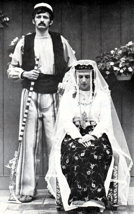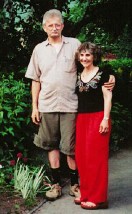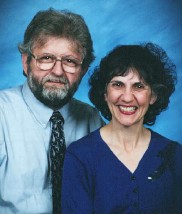|
Gary and Susan Lind-Sinanian
|
|
CLICK AN IMAGE FOR LARGER VIEW
 Gary and Susan Lind-Sinanian have lectured and taught Armenian dances in America and internationally since 1978 and are known as "high context" teachers. Their workshops incorporate extensive background in Armenian history, culture, costume, and folklore related to the dances. As museum curators of the largest Armenian museum in the United States, they bring a broad background in many areas of Armenian culture to their workshops. They are particularly well known in the Armenian community for teaching dance and culture to youth and small children at Armenian schools, camps, and cultural festivals.
Gary and Susan Lind-Sinanian have lectured and taught Armenian dances in America and internationally since 1978 and are known as "high context" teachers. Their workshops incorporate extensive background in Armenian history, culture, costume, and folklore related to the dances. As museum curators of the largest Armenian museum in the United States, they bring a broad background in many areas of Armenian culture to their workshops. They are particularly well known in the Armenian community for teaching dance and culture to youth and small children at Armenian schools, camps, and cultural festivals.
Gary and Susan Lind-Sinanian have researched the traditional dances of Western Armenia brought to the United States by the early immigrants. They have been locating and interviewing primarily elderly immigrants from now-vanished towns and villages in Eastern Turkey that were destroyed during the Armenian Genocide of 1915-1922. Many of these dances were only preserved and maintained as the fragmented patrimony of their heritage within the families of refugees who settled in North America. Some of these dances are popular in a modified form at American-Armenian picnics, weddings, and dances. Gary and Susan are learning and recording these dances to preserve this endangered form of Armenian folklore.
Gary is a dance notation teacher (Sutton Movement Shorthand) and has studied dance anthropology at the University of Massachusetts in Boston. He has lectured extensively on Armenian culture for museums, schools, libraries, and universities. His exhibits on the Armenian Genocide have been featured at several Holocaust centers.
 Susan is a teacher of special education (daily living skills for the blind) and has extensive background in dance and needlework. She teaches and demonstrates traditional Armenian folkcrafts including embroidery and Armenian needle lace, cooking, costume, storytelling, and fortune telling (with traditional coffee cups).
Susan is a teacher of special education (daily living skills for the blind) and has extensive background in dance and needlework. She teaches and demonstrates traditional Armenian folkcrafts including embroidery and Armenian needle lace, cooking, costume, storytelling, and fortune telling (with traditional coffee cups).
The Lind-Sinanians are the founders of the Middle East Folk Arts Cooperative and the directors of a dance group that performs traditional dances of western Armenia. They have lectured and taught dance workshops across the United States. They have performed in various Greek, Armenian, and Lebenese dance groups.
With the help of the Middle East Folk Arts Cooperative, Gary and Susan have developed an Armenian dance curriculum for elementary school teachers. This curriculum emphasizes the trditional village dances, particularly the song-dances, in which one sings as one dances (for example, Lepo Le Le and Hooshig Mooshig). The curriculum includes lyrics, written dance instructions, sheet music, and an accompanying recording, and is designed for use in both Armenian schools and in public school systems. In this manner, the rich legacy of the past is preserved and used to enrich the present.
Gary and Susan are on the staff of the Armenian Museum & Library of America (ALMA) in Watertown, Massachusetts. Gary is the curator, handling exhibits, collections, and library information, while Susan is the Textile Curator-Conservator, handling textile collections and volunteer information. Most of Gary's writings have been related to exhibits and events at ALMA.
Among the Lind-Sinanian's publications, articles, syllabi, and videos are:
- "A Boys Costume 1915." Gary Lind-Sinanian. Armenian Library and Museum of America, Watertown, Massachusetts.
- Dance Armenia: A collection of Armenian dances as danced at contemporary American-Armenian parties. 2nd Edition. Folk Arts Center of New England, Inc., 1978. 52p.
- "An Introductory Survey of Lebanese Dance." Gary Lind-Sinanian. Unpublished paper available through the Armenian Library and Museum of America, Inc., Watertown, Massachusetts.
- Other Voices, Other Songs: The Armenians. Susan and Gary Lind-Sinanian, consultants. Video.
Dances Gary and Susan have taught include Abaranjani Bar, Armenian Medley (Yeraz, Hovivner, Bijo), Armenian Misirlou, Armenian Polka, Bandee, Bar, Bardezeh Mer, Bijo, Chalakan, Chavlakian, Chifte Telli, Daldalar, Dabke 1 & 2, Dabke Bedawiye, Demale, Gavavik, Govand, Haire Mamougeh, Halay 1, 2, 3, 4, & 5, Hars ou Pesa, Hop 1, 2, 3, & 4, Kher Pan, Kochare, Khosh Bilezig, Khorodtsi Bijo, Kosh Bilezig, Koshisar Bijo, Lachi, Laou Bikoun, Laz Bar 1 & 2, Lebanese Drum Solo, Lorkay, Mamer, Mamyana, Mijwiz, Misirlou, Moush Halay, Papuri 1 & 2, Sepastia Bar, Shavalee, Sheikhani, Shuffle 1 & 2, Siroun Gakav, Syrtos, Tamzara 1 & 2, Tarakama, Tsamiko, Uzundara, Weili, Yarkhoshda, and Zurna Haleh.
